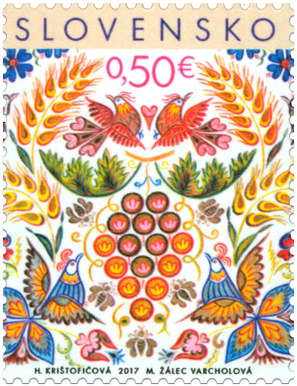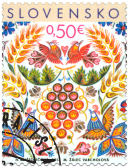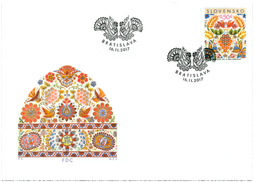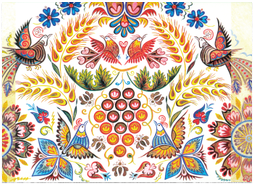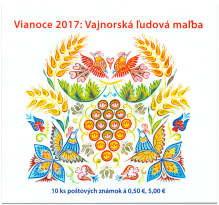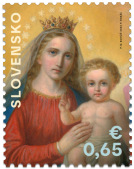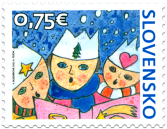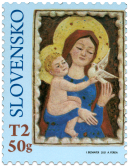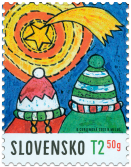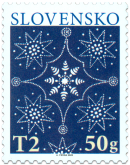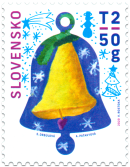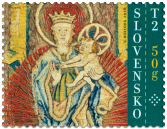648 Date of issue
16.11.2017 Face value
0.50 € Sell price
0.50 €
The motifs of vines, wheat ears, flowers, birds, bees and even pomegranates as depicted in preserved folk murals are symbols that, along with the gifts of nature on the festive table, still put the finishing touches to a traditional Christmas atmosphere today.
The issue includes reproductions of paintings from the Church of Our Lady of Seven Sorrows in Vajnory (today Bratislava’s city borough). It is one of the few mural items that have survived until today, a typical ornamental folk painting in its authentic form − applied in a manner and in an environment that are atypical of folk art. Murals originated in the village environment; there it developed from what was originally a functional painting of a fireplace in an open kitchen into a decorative interior painting. Over the centuries, this traditionally female art form in Vajnory acquired a characteristic ornamental form with motifs inspired by the surrounding countryside. Later, mainly due to the embroidery of liturgical fabrics, the composition of motifs was enriched by elements of Christian symbolism. In the early decades of the 20th century, ornamental art production was enriched and reached its peak thanks to Katarína Brúderová (1882-1964) - one of the greatest Slovak folk artists. The ornamental work of Vajnory influenced by her paintings and embroidery (e.g. the wall painting in the Slovak National Museum, her embroidery at an exhibition in London in 1911) came into a wider public cultural awareness both at home and abroad. The ornamental works of art in Vajnory came from a broad background of female artists of her generation and was also followed by a younger generation. In 1968, another folk artist of Vajnory, Hedviga Krištofičová (1909 – 1999), created the ornamental painting in the church. Mária Feketová, Terézia Zemanová, Mária Škvorcová and others coloured the template that she drew. These simple women of the last generation of uneducated folk artists continued to develop the tradition of the ornament. A number of works, preserved in their original form, as well as those transferred to other environments, are a testament to these simple, artistically uneducated, but real female folk artists. Their works of art are mature and authentic in terms of their artistic nature, and they are a priceless cultural heritage.
Antónia Paulinyová
© 2024 POFIS - Postal philatelic service. All rights reserved

